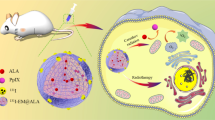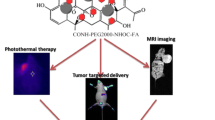Abstract
Purpose
To study contrast-enhanced MRI guided photodynamic therapy with a pegylated bifunctional polymer conjugate containing an MRI contrast agent and a photosensitizer for minimally invasive image-guided cancer treatment.
Methods
Pegylated and non-pegylated poly-(l-glutamic acid) conjugates containing mesochlorin e6, a photosensitizer, and Gd(III)-DO3A, an MRI contrast agent, were synthesized. The effect of pegylation on the biodistribution and tumor targeting was non-invasively visualized in mice bearing MDA-MB-231 tumor xenografts with MRI. MRI-guided photodynamic therapy was carried out in the tumor bearing mice. Tumor response to photodynamic therapy was evaluated by dynamic contrast enhanced MRI and histological analysis.
Results
The pegylated conjugate had longer blood circulation, lower liver uptake and higher tumor accumulation than the non-pegylated conjugate as shown by MRI. Site-directed laser irradiation of tumors resulted in higher therapeutic efficacy for the pegylated conjugate than the non-pegylated conjugate. Moreover, animals treated with photodynamic therapy showed reduced vascular permeability on DCE-MRI and decreased microvessel density in histological analysis.
Conclusions
Pegylation of the polymer bifunctional conjugates reduced non-specific liver uptake and increased tumor uptake, resulting in significant tumor contrast enhancement and high therapeutic efficacy. The pegylated poly(l-glutamic acid) bifunctional conjugate is promising for contrast enhanced MRI guided photodynamic therapy in cancer treatment.






Similar content being viewed by others
References
V. F. Dima, M. D. Ionescu, C. Balotescu, and S. F. Dima. Photodynamic therapy and come clinical applications in oncology. Rom. Arch. Microbiol. Immunol. 61:159–205 (2002).
T. J. Dougherty, C. J. Gomer, B. W. Henderson, G. Jori, D. Kessel, M. Korbelik, J. Moan, and Q. Peng. Photodynamic therapy. J. Natl. Cancer Inst. 90:889–905 (1998).
K. R. Weishaupt, C. J. Gomer, and T. J. Dougherty. Identification of singlet oxygen as the cytotoxic agent in photoactivation of murine tumors. Cancer Res. 36:2326–2329 (1976).
R. R. Allison, G. H. Downie, R. Cuenca, X. H. Hu, J. H. C. Childs, and C. H. Sibata. Photosensitizers in clinical PDT. Photodiagn. Photodynam. Ther. 1:27–42 (2004).
J. Shiah, Y.-E. Sun, C. M. Peterson, R. C. Straight, and J. Kopecek. Antitumor activity of N-(2-hydroxypropyl) methacrylamide copolymer-mesochlorin e6 and adriamycin conjugates in combination treatments. Clin. Cancer Res. 6:1008–1015 (2000).
F. N. Jiang, D. J. Liu, H. Neyndorff, M. Chester, S. Y. Jiang, and J. G. Levy. Photodynamic killing of human squamous cell carcinoma cells using a monoclonal antibody-photosensitizer conjugate. J. Natl. Cancer Inst. 83:1218–1225 (1991).
C. F. van Nostrum. Polymeric micelles to deliver photosensitizers for photodynamic therapy. Adv. Drug Del. Rev. 56:9–16 (2004).
A. S. L. Derycke, and P. A. M. de Witte. Liposomes for photodynamic therapy. Adv. Drug Del. Rev. 56:17–30 (2004).
H. Maeda, J. Wu, T. Sawa, Y. Matsumura, and K. Hori. Tumor vascular permeability and the EPR effect in macromolecular therapeutics: a review. J. Control Rel. 65:271–284 (2000).
M. B. Vrouenraets, G. W. M. Visser, G. B. Snow, and G. A. M. S. van Dongen. Basic principles, applications in oncology and improved selectivity of photodynamic therapy. Anticancer Res. 23:505–522 (2003).
E. van Leengoed, J. Versteeg, N. van der Veen, A. van den Berg-Blok, H. Marijnissen, and W. Star. Tissue-localizing properties of some photosensitizers studied by in vivo fluorescence imaging. J. Photochem. Photobiol. B. 6:111–119 (1990).
S. K. Pandey, A. L. Gryshuk, M. Sajjad, X. Zheng, Y. Chen, M. M. Abouzeid, J. Morgan, I. Charamisinau, H. A. Nabi, A. Oseroff, and R. K. Pandey. Multimodality agents for tumor imaging (PET, fluorescence) and photodynamic therapy. A possible “see and treat” approach. J. Med. Chem. 48:6286–6295 (2005).
K. Stefflova, J. Chen, and G. Zheng. Killer beacons for combined cancer imaging and therapy. Curr. Med. Chem. 14:2110–2125 (2007).
G. Li, A. Slansky, M. P. Dobhal, L. N. Goswami, A. Graham, Y. Chen, P. Kanter, R. A. Alberico, J. Spernyak, J. Morgan, R. Mazurchuk, A. Oseroff, Z. Grossman, and R. K. Pandey. Chlorophyll-a analogues conjugated with aminobenzyl-DTPA as potential bifunctional ligands for magnetic resonance imaging and photodynamic therapy. Bioconjug. Chem. 16:32–42 (2005).
R. Kopelman, L. Y. Koo, M. Philbert, B. A. Moffat, G. R. Reddy, G. McConville, P. Hall, D. E. Chenevert, T. L. Bhojani, and S. M. Buck. Multifunctional nanoparticles platforms for in vivo MRI enhancement and photodynamic therapy of a rat brain cancer. J. Magn. Mater. 293:404–410 (2005).
S. Gross, A. Gilead, A. Scherz, M. Neeman, and Y. Solomon. Monitoring photodynamic therapy of solid tumors online by BOLD-contrast MRI. Nat. Med. 9:1327–1331 (2003).
A. Vaidya, Y. Sun, T. Ke, E. K. Jeong, and Z. R. Lu. Contrast enhanced MRI-guided photodynamic therapy for site-specific cancer treatment. Magn. Reson. Med. 56:761–767 (2006).
T. Lammers, R. Kuhnlein, M. Kissel, V. Subr, T. Etrych, R. Pola, M. Pechar, K. Ulbrich, G. Storm, P. Huber, and P. Peschke. Effect of physicochemical modification on the biodistribution and tumor accumulation of HPMA copolymers. J. Control Rel. 110:103–118 (2005).
P. Bailon, A. Palleroni, C. A. Schaffer, C. L. Spence, W. J. Fung, J. E. Porter, G. K. Ehrlich, W. Pan, Z. X. Xu, M. W. Modi, A. Farid, W. Berthold, and M. Graves. Rational design of a potent, long lasting form of interferon: a 40kDa branched poly-ethylene glycol-conjugated interferon alpha-2a for the treatment of hepatitis C. Bioconjug. Chem. 12:195–202 (2001).
A. N. Lukyanov, R. M. Sawant, W. C. Hartner, and V. P. Torchilin. PEGylated dextran as long-circulating pharmaceutical carrier. J. Biomater. Sci. Polym. Ed. 15:621–630 (2004).
F. M. Veronese, O. Schiavon, G. Pasult, R. Mendichi, L. Andersson, A. Tsirk, J. Ford, G. Wu, S. Kneller, J. Davies, and R. Duncan. PEG-doxorubicin conjugates: influence of polymer structure on drug release, in vitro cytotoxicity, biodistribution, and antitumor activity. Bioconjug. Chem. 16:775–784 (2005).
D. E. Owens III, and N. A. Peppas. Opsonization, biodistribution, and pharmacokinetics of polymeric nanoparticles. Int. J. Pharm. 307:93–102 (2006).
A. Beeby, L. M. Bushby, D. Maffeo, and J. A. G. Williams. Intramolecular sensitization of lanthanide(III) luminescence by acetophenone-containing ligands: the critical effect of para-substituents and solvent. J. Chem. Soc, Dalton Trans. 1:48–52 (2002).
Z. P. Liang, and P. C. Lauterbur. Principles of Magnetic Resonance Imaging. IEEE, New York, NY, 1999.
Y. Feng, Y. Zong, T. Ke, E. K. Jeong, D. L. Parker, and Z. R. Lu. Pharmacokinetics, biodistribution and contrast enhanced MR blood pool imaging of Gd-DTPA cystine copolymers and Gd-DTPA cystine diethyl ester copolymers in rat model. Pharm. Res. 23:1736–1742 (2006).
D. M. Shames, R. Kuwatsuru, V. Vexler, A. Muhler, and R. C. Brasch. Measurement of capillary permeability to macromolecules by dynamic magnetic resonance imaging: a quantitative noninvasive technique. Magn. Resn. Med. 29:616–622 (1993).
L. L. Emerson, S. R. Tripp, B. C. Baird, L. J. Layfield, and L. R. Rohr. A comparison of immunohistochemical stain quality in conventional and rapid microwave processed tissues. Am. J. Clin. Pathol. 125:176–183 (2006).
J. M. Harris, N. E. Martin, and M. Modi. PEGylation: A novel process for modifying pharmacokinetics. Clin Pharmacokinet. 7:539–551 (2001).
M. R. Hamblin, J. L. Miller, I. Rizvi, B. Ortel, E. V. Maytin, and T. Hassan. Pegylation of a chlorin e6 polymer conjugates increases tumor targeting of photosensitizer. Cancer Res. 61:7155–7162 (2001).
M. R. Hamblin, J. L. Miller, I. Rizvi, H. G. Loew, and T. Hasan. Pegylation of charged polymer-photosensitizer conjugates: effects on photodynamic efficacy. Br J Cancer. 89:937–943 (2003).
F. Ye, T. Ke, E. K. Jeong, X. Wang, Y. Sun, M. Johnson, and Z.-R. Lu. Noninvasive visualization of in vivo drug delivery of poly(L-glutamic acid) using contrast-enhanced MRI. Mol. Pharm. 3:507–15 (2006).
J. Zheng, J. Liu, M. Dunne, D. A. Jaffray, and C. Allen. In vivo performance of a liposomal vascular contrast agent for CT and MR-based image guidance applications. Pharm. Res. 24:1193–1201 (2007).
Y. Wang, F. Ye, E. K. Jeong, Y. Sun, D. L. Parker, and Z.-R. Lu. Noninvasive visualization of pharmacokinetics, biodistribution and tumor targeting of poly[N-(2-hydroxypropyl)methacrylamide] in mice using contrast enhanced MRI. Pharm. Res. 24:1208–16 (2007).
M. T. Peracchia, C. Vauthier, C. Passirani, P. Couvreur, and D. Labarre. Complement consumption by poly(ethylene glycol) in different conformations chemically coupled to poly(isobutyl 2-cyanoacrylate) nanoparticles. Life Sci. 61:749–761 (1997).
M. Triesscheijn, M. Ruevekamp, M. Aalders, P. Bass, and F. A. Stewart. Outcome of mTHPC mediated photodynamic therapy is primarily determined by the vascular response. Photochem. Photobiol. 81:1161–1167 (2005).
R. Brasch, and K. Turetschek. MRI characterization of tumors and grading angiogenesis using macromolecular contrast media: a status report. Eur J Radiol. 34:148–155 (2000).
R. M. Stephen, and R. J. Gillies. Promise and progress for functional and molecular imaging of response to targeted therapies. Pharm. Res. 24:1172–1185 (2007).
H. Dvorak, J. Nagy, J. Dvorak, and A. Dvorak. Identification and characterization of the blood vessels of solid tumor that are leaky to circulating macromolecules. Am. J. Pathol. 133:95–109 (1988).
Y. Zong, X. Wang, K. C. Goodrich, A. M. Mohs, D. L. Parker, and Z. R. Lu. Contrast-enhanced MRI with new biodegradable macromolecular Gd (III) complexes in tumor bearing mice. Magn Reson Med. 53:835–842 (2005).
Acknowledgements
This research was supported in part by NIH grant R01 CA097465. We thank Melody Johnson of CAMT, University of Utah, Salt Lake City, Utah and Sheryl Tripp of ARUP Laboratories, Salt Lake City, Utah for their technical assistance.
Author information
Authors and Affiliations
Corresponding author
Rights and permissions
About this article
Cite this article
Vaidya, A., Sun, Y., Feng, Y. et al. Contrast-Enhanced MRI-Guided Photodynamic Cancer Therapy with a Pegylated Bifunctional Polymer Conjugate. Pharm Res 25, 2002–2011 (2008). https://doi.org/10.1007/s11095-008-9608-1
Received:
Accepted:
Published:
Issue Date:
DOI: https://doi.org/10.1007/s11095-008-9608-1




